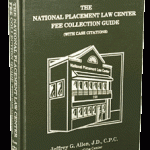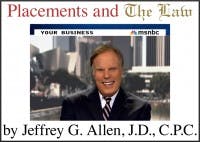The single biggest contingency fee collection defense is the so-called “but for” rule. Yet recruiters and their lawyers constantly use it as a legal rationale to get paid. When you start a fee collection with, “But for my referral . . .” it will likely end with, “. . . farewell five figure fee.”
Today, I’m going to explain why you should remove the words “but for” from any collection attempt.
Let’s start with this exercise:
- Say, “But for, WHAT FOR?”
- Go to www.placementlaw.com.
- Click the Placement Fee Collection Quiz at the beginning of the bottom row.
- Take the PFCQ.
- Click the Answers to Placement Law Quizzes at the end of the bottom row.
- Grade yourself.
Okay, we’re ready to rumble in the jungle. A few bars of Jungle Boogie, and let’s war  dance!
dance!
“But for” is an attempt to simplify the complicated “causation” matrix that we call “making a placement.” It states that, “’But for’ the referral, would the candidate have been hired?”
This is a linear probe. It’s linear because you are drawing an imaginary straight line between your referral (the cause) and the hire (the effect). The legal phrase for that straight line (between cause and effect) is efficient procuring cause.
It might work if recruiting reality presented a linear fact pattern. But it rarely does. Very few linear situations occur on the practical placement planet. Recruiters lock into that “but for” scenario in an attempt to persuade fee-avoiding employers to pay. Then their lawyers find reported cases that invoke the so-called “but for rule.”
Who’s It Good For?
The question isn’t whether the “but for” rule is good law. It is. The question is, “Good for whom?” If the answer is, “The employer.” ask yourself, “Why am I using it?”
Limited facts are known by the recruiter, since these cases usually arise after they’ve stopped working on the search. The so-called client refuses to pay. The turncoat candidate doesn’t even return calls. Now the abandoned, betrayed headhunter gets furious. He can’t even get anyone’s attention, so he whips out his blowgun and pumps the employer wildly with limited factual darts to “prove” that “but for” his involvement, a placement wouldn’t have occurred.
. . . and he simultaneously blows the fee.
Here’s your basic employer lawyer reply to a “but for” demand:
Your letter references the “well-settled” law that applies to this situation. As you know, New Jersey [where the employer is located] has only one reported decision in this area. In Michele Matthews, Inc. v. Kroll & Tract, 645 A2d 798, the court utilized the “efficient procuring cause” test to determine whether an employment agency has earned a fee.
In other words, to prevail [the recruiter] must be able to establish by a preponderance of the evidence [the plaintiff’s burden of proof] that it caused [the candidate and the employer] to negotiate, and that [the candidate] was hired by [the employer] as a result of its efforts. As you know, Illinois law [where the recruiter is located] would provide for the same result. . .
Using ‘But For’ As a Defense
He just set up the legal trap. Now he’ll spring it with a factual, “Snap!”
[T]he correspondence between our clients does not clearly support the allegations that [the recruiter] or his office were the efficient procuring cause of [the candidate’s] employment.
Can you hear what just happened in this very typical case? The “but for” rule isn’t getting a recruiter paid. It’s being used as a defense to payment. The employer lawyer figured out how to scribble that straight line going from the referral (cause) to the hire (effect). A one-sentence defense works when company employees (including the candidate) depend on the employer for survival.
If you’ve never made a placement, a “but for” cause-and-effect sounds reasonable enough. That’s why pre-placers think making placements is like bowling. All you have to do is pick up the ball (candidate), roll it down the alley, and make a strike (a hire). It may bend slightly, but essentially it’s an uninterrupted straight line.
But once you’ve worked long enough to cash that first draw check, you figure out that making placements is far more like pinball. You pull the plunger, shoot the ball, work the flippers, watch as it rolls around and hits the big bumper (and lights up – an interview!), rolls, spins, ricochets, delays, slides, and takes twists and turns like no other play you’ve ever made. You watch from the outside-in as these events take place, and eventually the ball reaches the jackpot (a hire).
Legally, each one of those bumps, rolls, spins, ricochets, delays, slides, twists and turns is called an intervening act. Simple enough. Something that happens after you shoot the ball.
Intervening Acts
Not so fast. There are two types of intervening acts.
A dependent intervening act is one caused by you. Pulling the plunger or working the flippers. Everything between that and the jackpot is a causation question. Was hitting the big bumper (an interview) caused by you? If it was caused by a ricochet (let’s say an employee referral), the employer’s argument is that it was an independent intervening act. It had nothing to do with you. The turncoat candidate and employer agree. There may even be a document trail that “substantiates” this.
No sale. So someone tells you about the ol’ “but for” rule. Yeah, that’s it! You say, “But for’ me pulling the plunger, the ball would have never been on the playing field.” It’s an open invitation for a fee-avoiding employer to set up a variety of factual defenses. “But for” the candidate meeting someone from the employer at a trade show, “but for” the resume already in the employer’s data base, “but for” your failure to obtain the candidate’s consent to the referral, “but for” the employee referrer convincing the candidate to interview, and an infinite number of other “but-for bumpers” that will have you flipping your five-figure fee into the forest. It’s the ultimate headhunter’s ambush.
Here are two ways the “but for rule” is misused by recruiters attempting to collect:
1. Another earlier recruiter is claiming the fee.
Whatever he did before your involvement was not an intervening act, so has no effect on the causation issue. The first recruiter may be entitled to a full fee contractually due to the one-year referral period. But that’s a contract with the employer. If you also have a contract with the employer, it may well be liable for two fees.
Just don’t get involved in any discussions with the first recruiter, or you risk getting maneuvered into a split-fee deal.
2. Interim employment of the candidate.
Whether or not the candidate accepted another gig after your referral has no effect on the causation issue either. But it sure makes it easy to chiropractically adjust the body of proof. The candidate can easily say he was considering pursuing that earlier referral. The employer can easily say it had the candidate’s resume and contacted him directly or through the first recruiter. An earlier recruiter can easily say he presented the candidate again.
Any of these things – and an infinite number of others – can be effectively used to trap you when you rely on the “but for” rule. There’s simply no way to extricate yourself when you’re the one who framed the conversation. You cleared away the bushes to make a linear legal path going from the referral to the hire. There’s no turning back. There’s only getting lured into a factual Snap!
 I cover this in detail in The National Placement Law Center Fee Collection Guide.
I cover this in detail in The National Placement Law Center Fee Collection Guide.
Try using my fee-getting, legal-sounding, polysyllabic phrase, substantial cause. Just say, “My referral was a substantial cause of the hire!” It keeps favorable facts in placement play because it’s impossible to argue that you didn’t plunge and flip. Pinball, not bowling.
“But for,” WHAT FOR?
May you collect this and every other well-earned fee!
